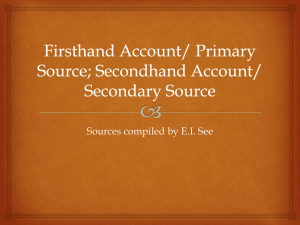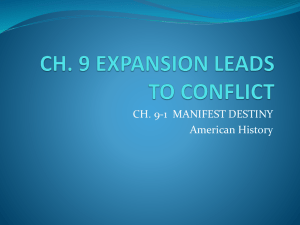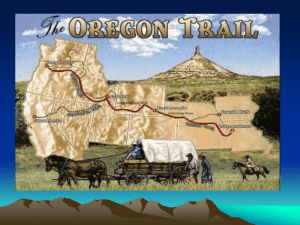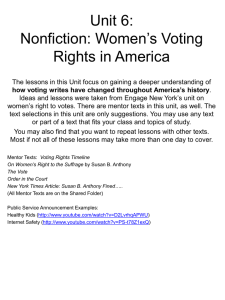Firsthand and Secondhand Accounts
advertisement
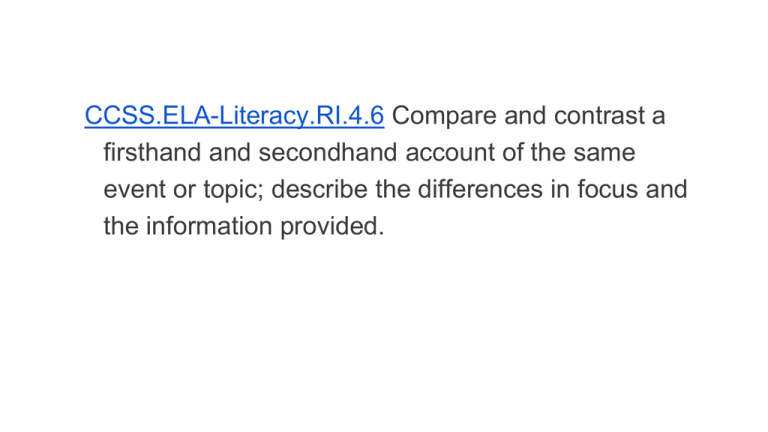
CCSS.ELA-Literacy.RI.4.6 Compare and contrast a firsthand and secondhand account of the same event or topic; describe the differences in focus and the information provided. Learning Objective: Compare and contrast a firsthand and secondhand account of the same event or topic; describe the differences in focus and the information provided. What are we comparing and contrasting today? Today we will compare and contrast a firsthand and secondhand account of the same event or topic. What are we describing today? Today we will describe the differences in focus and the information provided. Partner ShareWhen was the last time you saw a group of people witness an event? Partner ShareWhen was the last time you saw a group of people witness an event? Would they all have seen the exact same thing? Or did they see the same thing in a different way? What do you see here? What do you see here? Do you see an older woman? What do you see here? Do you see an older woman? Or do you see a younger woman? What is a narrator? A narrator is the person who is telling the story or wrote the text. What is a narrator? First Person - the narrator is in the story. Uses “I”. Third Person - the narrator is not in the story. Uses “he,” “they.” Points of View A firsthand account of an event or topic is based on an author’s personal experience. The author uses pronouns such as I, me, and we to describe the event or topic. Examples: Diaries autobiographies, and letters Points of View A secondhand account of an event or topic is based on an author’s research, rather than personal experience. The author uses pronouns such as he, she, and they to describe the event or topic. Examples: Encyclopedia entries, biographies, textbooks Why is it important compare and contrast firsthand and secondhand accounts? Why is it important compare and contrast firsthand and secondhand accounts? Each of us has a unique point of view. When we put our points of views together we can form a better understanding of the events that happen in our world. The passages that follow are two accounts of the same topic: the Oregon Trail. One is a firsthand account and one is a secondhand account. Read each and then see how to compare and contrast them. SOURCE A The Oregon Trail In 1843, thousands of people began traveling across America to the open lands of the West. Most of these people followed a path known as the Oregon Trail. Pioneers set out from towns along the Missouri River in the Midwest. They made a 2,000-mile trek to their new homes in California and Oregon. Some traveled in covered wagons. Others were on foot or horseback. The route was filled with danger and hardship. The passages that follow are two accounts of the same topic: the Oregon Trail. One is a firsthand account and one is a secondhand account. Read each and then see how to compare and contrast them. SOURCE B from Across the Plains in 1844 August 1st we nooned in a beautiful grove on the north side of the Platte [River]. We had by this time got used to climbing in and out of the wagon when in motion. When performing this feat that afternoon, my dress caught on an axle helve. I was thrown under the wagon wheel, which passed over and badly crushed my leg before my father could stop the team. He picked me up and saw the extent of the injury … The news soon spread along the train and a halt was called. A surgeon was found and the limb set … Which is the firsthand account? SOURCE B Which is the firsthand account? SOURCE B Which is the firsthand account? ● The author is a young girl telling about an actual experience she had on the Oregon Trail. ● She uses the pronouns we, I, and me to describe the experience. Which is the secondhand account? SOURCE A Which is the secondhand account? SOURCE A Which is the secondhand account? ● The author did not actually travel on the Oregon Trail. ● Instead, the author uses researched information to tell about what the Oregon Trail was. ● The author uses the pronoun they. Compare and Contrast How are the accounts similar? Both are about the Oregon Trail. Both tell about the danger and hardship people experienced on the Oregon Trail. How are the accounts different? The secondhand account focuses on broad, general information about the Oregon Trail. It tells readers that the route was dangerous. The firsthand account focuses on a single, specific experience that happened on the Oregon Trail. It shows readers that the route was dangerous by giving details about a particular person’s journey on the trail. More Practice Click the link, download the practice and print for your class. http://mhschool.com/lead_21/grade4/pdf/ccslh_g4 _ri_2_2d_link2.pdf Closure -What did we learn about today?Why are firsthand accounts important? -Why are secondhand accounts important? Independent Practice Click the link, download the practice and print for your class. https://docs.google.com/file/d/0B9KphDzVc2wQT2ljS0c3WUl WU28/edit Credits and Sources http://mhschool.com/lead_21/grade4/ccslh_g4_ri_2_2d.html http://www.internet4classrooms.com/common_core/compare_contrast_firsthand_secondhand_account_same_reading_informa tional_text_fourth_4th_grade_english_language_arts.htm http://mcsfourthgrade.wikispaces.com/RI-Craft+%26+Structure
